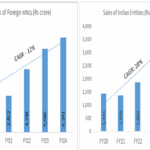- Study finds that 32% of ultra-processed food and beverage products in India meet WHO regional thresholds for salt, sugar and saturated fats
- Experts believe finding reinforces importance of evidence-based cut-offs on salt, sugar and fats and front of pack labelling
India
healthysoch
Chandigarh, December 01, 2021 :
A recent analysis of more than 10,000 food and beverage products currently available in the Indian food market, has revealed that about 68% of these products have excess amounts of at least one ingredient of concern whereas 32% are within the scientific thresholds recommended WHO regional standards. As the Food Safety Standards Authority of India (FSSAI) prepares to adopt a front-of-the-pack food label (FOPL), public health experts and consumer rights organisations have welcomed this finding which demonstrates that the nutrient profile model (NPM) from the WHO Southeast Asian Regional Office (SEARO) is appropriate and practicable for the Indian ultra-processed food market and may encourage the industry to embrace science and evidence-based cut-offs on salt, sugar and saturated fat.
India faces a rapidly escalating burden of non-communicable diseases (NCDs), particularly the rising incidence of nutrition related diseases such as diabetes, obesity among adults as well as an alarming increase in childhood obesity. The simultaneous and exponential growth of the ultra-processed food industry has raised concern about the food choices available to people in the market.
India clocks the highest growth rate for ultra-processed food and beverages – items high in added sugar, salt and additives, besides being ultra-processed. According to Euromonitor sales data from 2006-2019, the retail value of packaged junk food and soft drinks in India grew by 42 times in just 13 years. Over the past year, FSSAI has been preparing to introduce a mandatory FOPL on all packaged foods which will require the food industry to ensure that ingredients of concern are within a certain threshold and also guide consumers towards making healthy choices. Globally the ‘big food’ has been known to resist these regulations making varied claims such as reformulation impacting profit margins and pricing or that healthy ingredients can offset the harm of negative nutrients.
Earlier this year researchers from the All India Institute of Medical Sciences (AIIMS) and the University of North Carolina at Chapel Hill (UNC) used data from the Mintel Global New Product Database which includes all major products of the Indian food market and includes 35,142 products. Researchers were able to analyze 10,500 products that had provided complete nutrition information in the nutrition facts panel. S
peaking at a national consultation, co-author of the paper, Dr Chandrakant S. Pandav, Padma Shri Awardee 2021 said, “Our study finds that applying the SEARO NPM cut-off points would result in 68% of products in the market requiring at least one warning label. This is in stark contrast to an earlier study undertaken by Nutrition Alchemy, utilizing a small dataset of 1,300 which found that 96% of products would require a label. This creates an erroneous impression that FOPL based on the SEARO NPM is not practicable and based on the ground reality. A team of researchers and nutritionists from UNC who have done similar analyses across many countries (the US, Mexico, Chile, Peru and South Africa and assisted the UK Dept of Health) and are experts in understanding nutrition information and food labels came together for this important study which can aid the FOPL process in India.”
Ms Vandana Shah, Regional Director, Global Health Advocacy Incubator, which is supporting regulators around the world in adopting and implementing strong FOPL drew attention to the growing momentum of countries adopting warning label style FOPL for better health outcomes of their citizens. “There is growing evidence from countries like Argentina, Chile and Brazil that adopting a warning label style FOPL with WHO regional thresholds can lead to reduction in consumption of the most unhealthy ultra-processed foods and beverages. India could lead the way in South Asia by adopting an effective FOPL based on scientific cut offs which is one of the most effective ways of preventing obesity and nutrition-related NCDs like diabetes and hypertension. Findings of this study validates the practicability of the WHO regional cut offs for India, while also reaffirming that the Indian food industry is well prepared to keep up with global standard regulations.”
The apex food safety regulator of the country is keen to bring about the much-awaited regulation on FOPL. To gather consensus, it has held several rounds of consultations with industry, civil society and consumer groups since the beginning of 2021 and also constituted a working group. As per this report, the working group was being guided by the findings of the Nutrition Alchemy report. The industry too was unwilling to go for nutrition cut-offs that would force most of the products to be reformulated. “Decisions based on this new report which relies on a much larger sample will bring reassurance to industry,” said Mr Ashim Sanyal, COO, Consumer VOICE and erstwhile member of the consultative committee constituted by FSSAI. “We applaud FSSAI for its inclusive approach in determining the right FOPL for India and hope that findings of this report can make a strong case for WHO SEARO nutrient profile which can be the basis for simple, interpretive warning labels that are best for consumers.”
NPM is a scientific method to categorize food and beverage items according to their nutritional composition with the ultimate aim of identifying and differentiating foods that are unhealthily high in salt, sugar, and saturated fats. Based on the “cut off” established by the NPM, the front-of-pack label informs consumers in a fast and straightforward way whether a product contains excessive sugar, sodium and saturated fat, helping them make a healthier choice. The WHO SEARO NPM model was developed based on research and field level studies in consultation with member countries of the South-East Asia region and is therefore considered best aligned to the Indian food system.
healthysoch







